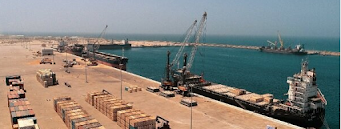India is getting ready to begin full-scale operations of its
first foreign sea port venture Chabahar in Iran by May end this year. This
facility located on the Gulf of Oman aims at facilitating South Asia, Central
Asia and West Asia trade.
Indian US$500 million investment represents a clear and
potent commercial challenge to China’s massive port investment in Gwadar port
located in Pakistan, a key component of Beijing’s Belt and Road Initiative
(BRI).
According to a report by Asia Times, India has nearly
completed development of two terminals at Chahabar’s Shahid Beheshti complex
that opens onto the Gulf of Oman.
The 10-year lease agreement, a deal first clinched by Prime
Minister Narendra Modi in Tehran in 2016, has until now been hobbled by US
sanctions imposed under the Donald Trump administration.
Indian suppliers and engineers, some with interests in the
US, were reluctant to deliver essential machinery and services to Iran on fears
they could face sanctions, despite clear exemptions on Chabahar in Trump’s
sanction order. That led to certain speculation that China may take over the
project from India.
Now, New Delhi has accelerated the project with the shift
from Trump to Joe Biden, banking like others on a new breakthrough on the Joint
Comprehensive Plan of Action (JCPOA) and a broader US-Iran warming trend.
“I will inaugurate the fully operationalized Chabahar port
in April or May,” Mansukh Mandaviya, Indian Ports & Shipping Minister, said
in a recent virtual discussion on Iran’s Chabahar port.
India has supplied two large cargo-moving cranes and will
deliver two more in the coming weeks before the facility’s expected ceremonial
opening next month.
New Delhi is already promoting the port’s potential
humanitarian role, noting it was used to send emergency shipments of wheat to
Afghanistan during the COVID-19 crisis and pesticide to Iran to deal with a
recent locust infestation.
Chabahar has seen limited operations since 2019 due to the US
restrictions imposed on Iran’s energy exports. The port handled a mere 123
vessels with 1.8 million tons of bulk and general cargo from February 2019 to
January 2021, well below its operating capacity, according to reports.
New Delhi ultimately aims to link Chabahar to its
International North-South Transport Corridor (INSTC), a project initially
proposed by India, Russia, and Iran in 2000 and later joined by 10 other
Central Asian nations.
Some see the INSTC as a less talked about rival to China’s
BRI, which has invested heavily in Pakistan’s road, power and trade
infrastructure, including huge multi-billion-dollar investments at Gwadar port.
INSTC envisions a 7,200 kilometer-long, multimode network
comprised of shipping, rail, and road links connecting India’s Mumbai with
Europe via Moscow and Central Asia. Initial estimates suggest INSTC could cut
current carriage costs by about 30% and travel times by half.
Iran has already started working on a 600-kilometer-long
railway line connecting Chabahar port to Zahedan, the provincial capital of
Sistan-Baluchestan province close to the Afghan border.
Chabahar port consists of Shahid Kalantari and Shahid
Beheshti terminals, each of which has five berth facilities. The port is
located in Iran’s Sistan-Balouchestan Province and is about 120 kilometers
southwest of Pakistan’s Baluchistan province, where the China-funded Gwadar
port is situated.
In May 2016, India, Iran, and Afghanistan signed a
trilateral agreement for the strategically-located Chabahar to give New Delhi
access to Kabul and Central Asia.
The original plan committed at least US$21 billion for Chabahar–Hajigak
corridor, which included US$85 million for Chabahar port development, a US$150
million credit line for Iran, an US$8 billion India-Iran MOU for Indian
industrial investment in a Chabahar special economic zone, and US$11 billion
for the Hajigak iron and steel mining project awarded to seven Indian companies
in central Afghanistan.
Hajigak is the best known and largest iron oxide deposit in
Afghanistan. It is located near the Hajigak Pass, with its area divided between
Maidan Wardak and Bamyan provinces.
Unlike Chabahar, which is designed more to serve the
economic and trade interests of the wider region, Gwadar is more tilted toward
Beijing’s ambitions, analysts and traders say.
Riaz Haq, founder and president of PakAlumni Worldwide wrote
in a recent blog that “China is looking to build and use Gwadar in Pakistan as
Hong Kong West to serve as a superhighway for China’s trade expansion in [the]
Middle East (West Asia), Africa and Europe.”
Gwadar port’s planned capacity will accommodate a massive
300 to 400 million tons of cargo annually, comparable to the combined annual
capacity of all Indian ports. It also dwarfs the 10-12 million tons of cargo
handling capacity now planned for Chabahar.
In another comparison, the largest US port at Long Beach,
California, handles 80 million tons of cargo, about a quarter of what Gwadar
could handle upon completion of a project that is designed largely to receive
and move China’s trade.















